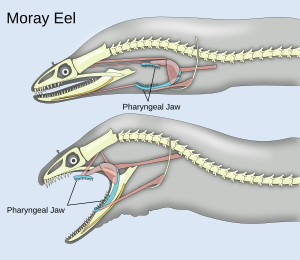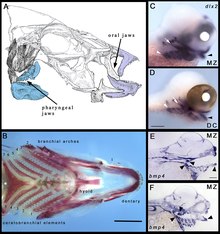

Pharyngeal jaws are a "second set" of jaws contained within an animal's throat, or pharynx, distinct from the primary or oral jaws. They are believed to have originated as modified gill arches, in much the same way as oral jaws. Originally hypothesized to have evolved only once,[1] current morphological and genetic analyses suggest at least two separate points of origin.[2][3] Based on connections between musculoskeletal morphology and dentition, diet has been proposed as a main driver of the evolution of the pharyngeal jaw.[4][5] A study conducted on cichlids showed that the pharyngeal jaws can undergo morphological changes in less than two years in response to their diet.[6] Fish that ate hard-shelled prey had a robust jaw with molar-like teeth fit for crushing their durable prey. Fish that ate softer prey, on the other hand, exhibited a more slender jaw with thin, curved teeth used for tearing apart fleshy prey.[5] These rapid changes are an example of phenotypic plasticity, wherein environmental factors affect genetic expression responsible for pharyngeal jaw development.[6][7] Studies of the genetic pathways suggest that receptors in the jaw bone respond to the mechanical strain of biting hard-shelled prey, which prompts the formation of a more robust set of pharyngeal jaws.[7]
- ^ Harvard University.; University, Harvard (1981–1986). Breviora. Vol. no.464-487 (1981-1986). Cambridge, Mass.: Museum of Comparative Zoology, Harvard University.
{{cite book}}:|volume=has extra text (help) - ^ Mabuchi, Kohji; Miya, Masaki; Azuma, Yoichiro; Nishida, Mutsumi (2007). "Independent evolution of the specialized pharyngeal jaw apparatus in cichlid and labrid fishes". BMC Evolutionary Biology. 7 (1): 10. doi:10.1186/1471-2148-7-10. PMC 1797158. PMID 17263894.
- ^ Wainwright, Peter C.; Smith, W. Leo; Price, Samantha A.; Tang, Kevin L.; Sparks, John S.; Ferry, Lara A.; Kuhn, Kristen L.; Eytan, Ron I.; Near, Thomas J. (2012). "The Evolution of Pharyngognathy: A Phylogenetic and Functional Appraisal of the Pharyngeal Jaw Key Innovation in Labroid Fishes and Beyond". Systematic Biology. 61 (6): 1001–1027. doi:10.1093/sysbio/sys060. ISSN 1063-5157. JSTOR 41677996. PMID 22744773.
- ^ Grubich, Justin (2003). "Morphological convergence of pharyngeal jaw structure in durophagous perciform fish". Biological Journal of the Linnean Society. 80 (1): 147–165. doi:10.1046/j.1095-8312.2003.00231.x. ISSN 1095-8312.
- ^ a b Aguilar-Medrano, Rosalía (January 2017). "Ecomorphology and evolution of the pharyngeal apparatus of benthic damselfishes (Pomacentridae, subfamily Stegastinae)". Marine Biology. 164 (1): 21. Bibcode:2017MarBi.164...21A. doi:10.1007/s00227-016-3051-3. ISSN 0025-3162. S2CID 90985865.
- ^ a b Gunter, Helen M.; Fan, Shaohua; Xiong, Fan; Franchini, Paolo; Fruciano, Carmelo; Meyer, Axel (2013-08-19). "Shaping development through mechanical strain: the transcriptional basis of diet-induced phenotypic plasticity in a cichlid fish". Molecular Ecology. 22 (17): 4516–4531. Bibcode:2013MolEc..22.4516G. doi:10.1111/mec.12417. ISSN 0962-1083. PMID 23952004. S2CID 17490095.
- ^ a b Schneider, Ralf F.; Li, Yuanhao; Meyer, Axel; Gunter, Helen M. (2014-07-30). "Regulatory gene networks that shape the development of adaptive phenotypic plasticity in a cichlid fish". Molecular Ecology. 23 (18): 4511–4526. Bibcode:2014MolEc..23.4511S. doi:10.1111/mec.12851. ISSN 0962-1083. PMID 25041245. S2CID 8021527.